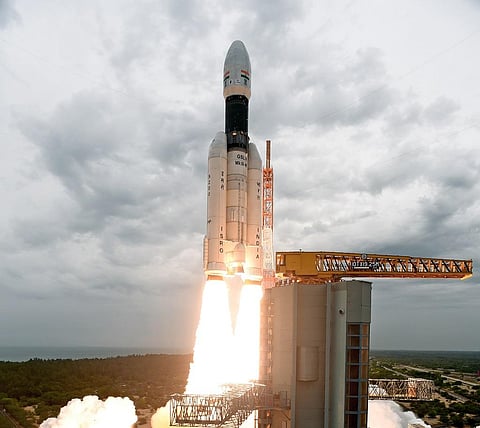

The Centre earmarked Rs 13,700 crore for the Department of Space (DoS) in the Union Budget 2022-23, as Indian Space Research Organisation (ISRO) gears up for Gaganyaan — India’s first human spaceflight mission. The allocations, however, have drawn mixed reactions from experts.
ISRO will receive the lion’s share of the space budget. Its affiliated centres will receive Rs 10,534.5 crore under the space technology category.
The budget has not seen a significant gain from the revised estimates of Rs 12,642 crore for the current fiscal (2021-22), said Aniket Sule, associate professor at the Homi Bhabha Centre for Science Education, Tata Institute of Fundamental Research.
It is difficult to gauge if the department has been getting sufficient funds because the officials are not forthcoming about the stages of development of their ongoing projects, he said. ISRO, however, also generates income from launching foreign satellites, Sule added.
“This is one scientific sector that has done well,” Soumitro Banerjee, professor, Indian Institutes of Science Education and Research (IISER) Kolkata, told Down To Earth. The money allotted to the department is justified but they will need more support, he added.
“The government has already prioritised the Gaganyaan Mission and they will also be launching Chandrayaan 3. These are all baked into the budget,” Prasad, the co-founder of satsearch.co, a global marketplace for the space industry, said.
The allocations will translate into a few launches a year, he said. “This trend will likely continue for the next 10 years.”
India launches roughly five-seven satellites per year. In contrast, the United States, China and Russia had 19, 25 and 34 satellite launches, respectively, in 2019, according to reports.
The global space economy was close to $447 billion in 2020. Of this, India’s share was only about two per cent, much behind the US and China, according to the Economic Survey 2021-2022.
Upcoming missions
Chandrayaan 3 mission is slated for launch in August 2022. Also in the pipeline are Small Satellite Launch Vehicle; Aditya Ll spacecraft to study the solar atmosphere; XpoSat, an X-ray observatory satellite; and Indian Regional Navigation Satellite System, a regional navigation satellite system.
“For the much-awaited Gaganyaan mission, ISRO will be conducting at least two tests on crew abort and escape systems before proceeding to the first uncrewed mission early next year,” said Somnath S, chairperson of ISRO, to The Times of India.
The agency will launch an uncrewed mission to demonstrate technology, safety and reliability before the crewed flight in 2023.
However, Narayan Prasad, a space entrepreneur, expressed doubts over this timeline. “I don’t expect the launch to go through until 2025-2026, unless they increase the risk factor,” he said.
People’s lives are involved here, he said, adding that “it is not as easy as a robotic mission. You can’t just press a button and send people up,” he said.
The space agency will have to perform several tests, and the workforce will need enough training to respond to different situations, he said. “Thousands of things can go wrong,” he explained.
In 2024, ISRO is expected to launch the Shukrayaan Venus mission; DISHA, a twin aeronomy satellite mission that will study the uppermost layer of Earth's atmosphere; and Thermal infraRed Imaging Satellite for High-resolution Natural resource Assessment in collaboration with France to observe Earth’s surface.
Low budget, private contribution
ISRO is known for its low-budget space missions. For instance, India spent Rs 450 crore on the Mars Orbiter Mission (MOM), a fraction of what the United States shelled out for NASA's Mars Atmosphere and Volatile Evolution (MAVEN) spacecraft.
“Not everything can be done cheap,” said Banerjee, adding that low-budget can be a deterrent in some ways.
India’s missions tend to have a shorter lifespan. American missions, on the other hand, last for decades, Chaitanya Giri, a fellow for space and ocean studies at Gateway House — a think tank focussing on India’s global relations — told Business Insider India.
Also, India has been able to pull off low-cost missions due to lower salaries of the workforce and cost of living, Sule pointed out.
It is unfair to compare India with US, said Prasad. “Space can thrive in an economy which is itself thriving,” he said.
But budgetary constraint does not mean all is lost. “It is a question of smart thinking. They should create an appetite for the private sector to invest,” he said.
In 2020, the Centre opened up the space sector for private players. To support them, the cabinet approved the formation of the Indian National Space Promotion and Authorization Centre (IN-SPACe) under ISRO.
The 2021-2022 Economic Survey highlighted that IN-SPACe received close to 40 proposals from large industries, micro, small and medium enterprises, start-ups and academia for manufacturing launch vehicles and satellites.
The report also added that the number of space start-ups shot up to 100 in 2021, from one in 2012.
Prasad said things are not as rosy as they look. “The opening up of the space sector for private players will happen when the government becomes the anchor customer by procuring rockets and satellites from the private set up,” he said.
“This way, they can create demand. Consequently, the industries will invest in competing for that demand. That’s the real opening and we’ve not seen that happen,” he pointed out.
The government expects companies to get international customers, which is problematic. “You cannot just throw them into the ocean. Local demand needs to be created,” he added.